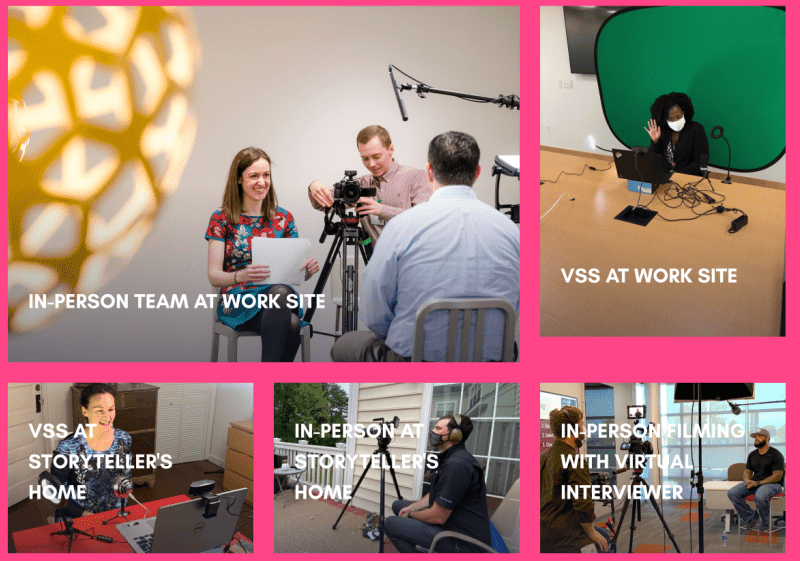Breaking Down the Challenges of Employer Branding in the Government Contracting Industry
Employer branding for government contracting is different than creating employer brand content for a commercial business. You’ll uncover a treasure trove of employee stories tied to mission and purpose, which is a recruitment marketer’s dream. However, this industry has unique challenges for communicating culture to the right candidates.
You’re competing with leading private sector tech companies to recruit top tech talent. You’re working to show candidates your commitment to increasing diversity, equity and inclusion. And, you need to show candidates what their employee experience will really look like, whether they’re working remotely or on-site for a government department or agency. Plus, you’re striving to retain your current employees, in a climate where talent with federal security clearance is in hot demand.
The answer, of course, is employee stories, but especially those stories that provide candidates with essential employee experience information and specific insights into culture.
We’ve worked with leading companies in the government contracting industry clients and have learned a few things along the way. We hosted a LinkedIn Live in which we shared our storytelling-based solutions.
And, here’s a breakdown of how we’ve helped them solve the most pressing employer branding challenges they’re facing today.
Challenge 1: Government contracting companies are competing with the traditional tech companies for top technical talent.
All entities — private, public and government contracting, which straddles both — are in a race for highly qualified technologist talent. However, governments and other customers are requiring increasingly complex digital solutions. And that means, defense contractors need more and more engineers, software developers, seasoned technical program managers, and other technical roles.
But, government contracting companies find themselves competing with traditional tech companies for this limited pool of talent. These tech competitors often have stronger name recognition when it comes to tech, offer higher salaries, and have the perception of being more progressive when it comes to company culture, remote work, and flexibility.
So, if your government contracting organization has adopted remote work and other calling cards of flexible, progressive culture, tell candidates about it. According to a 2021 survey, 82% of government contracting companies are planning to continue with remote work after COVID risks subside. The solution is to create content that communicates the remote/hybrid work experience and make it accessible on your career site and in job descriptions. This will make it easier for your company to compete with tech companies for candidates that prioritize remote and hybrid work.
Another cultural advantage that government contracting companies have in abundance: mission and purpose. Stories Inc. helped one of the biggest names in government contracting, aerospace and defense – Lockheed Martin – bring their mission to life. Their EVP is “Experience a mission that matters” and we developed for them a video series centered around the five foundational pillars that communicate life at Lockheed Martin and how employees connect to the organization and its mission. Of course, employee stories are what shows the employees connection to the mission and culture.
This mission-story-centered content is part of Lockheed Martin’s innovative recruitment marketing strategy. These stories work to help Lockheed Martin recruit and retain in-demand tech talent in today’s market.
And that leads us to…
Challenge 2: Retention, especially for those employees in which you’ve invested in federal security clearances.
To bolster retention, you again need to lean into your company’s unique combination of mission and employee experience to help re-engage and celebrate your team members.
For Lockheed Martin, we interviewed 30 storytellers across Lockheed Martin’s three locations and eight business areas. All of these employee storytellers shared multiple, original and personal stories of how they have experienced the mission and what it means to them. Now, Lockheed Martin uses the stories not just externally, but they’re a major element of their internal comms and employee engagement content.
They present the stories on their internal channels as an invitation for more employees to share their own stories, too. This creates a flywheel cycle of stories and employee engagement.

Challenge 3: Communicating DEI effectively
Both candidates and current employees are keenly interested in your company’s DEI commitment and they want to hear about it from your people experiencing inclusion. They also want to hear from voices leading real changes in your DEI journey, because inclusion is a constant process.
The best diversity and inclusion content shows your commitment to inclusion, belonging and diversity through real employee experiences. Unfortunately, many government contracting organizations create “diversity content” with stock photos and videos, and EEO statements. They’re not providing stories.
Instead, government contracting companies can show that they value diversity and inclusion by uncovering and amplifying a variety of employee voices from throughout the organization. That’s the only way to prove your actions are making a real impact for your underrepresented employees.
Employee resource groups (ERGs) are a critical resource and source of empowerment to underrepresented team members. If you have involved ERGs, there are great stories there. This video we developed for BAE Systems, Inc. features stories of inclusion and community from members of multiple ERGs throughout the company.
This DEI video is one of 18 we developed for BAE Systems’ career site (read more about the whole project in our BAE Systems case study).
If you find it hard to source stories that show a culture of inclusion and diversity, you can let candidates know that this is a big priority for your company. Feature stories of the work you’re doing to change. You can feature stories from the people leading major diversity and inclusion initiatives. Show candidates and employees where you are on the journey and where you’re working to go.
We also recommend adding DEI messages throughout all of your content — show that this is an important, prevailing, ever-present cultural reality. You don’t have to develop one singular DEI video and call it a day—address inclusion throughout all your messaging.
Challenge 4: Showing the employee experience when people are working remotely or on-site with government clients.
We often ask our employee storytellers about favorite moments or the projects they’re proud of. For government contractors in a secure environment, these details may be protected information. Government contracting has also traditionally faced the hurdle of showing culture while team members are often either working in a secure environment or on client location, so you can’t “show the office.” The rise of remote work has added to this challenge, too.
This is when virtual means of capturing stories from team members can meet these challenges and bring the hybrid and remote employee experience and culture to life. Our Virtual Story Session Service started when we couldn’t capture stories on-site due to the pandemic, and it’s a capability that continues to be more and more useful in communicating today’s virtually-distributed culture. We send storytellers a tech pack and conduct their interviews virtually, or via a hybrid in-person/virtual method.

And as you can see in this photo, we can also send green screens so that secure backgrounds can stay secure. And, some companies appreciate the ability to have a professional or uniform look to interviewees’ backgrounds. See if you can spot when a green screen is in use in this video we developed for Lockheed Martin using a hybrid virtual and in-person process!
As you can see from this example, virtually-captured stories can still have a high-quality and consistent look-and-feel, befitting a government contracting company’s professionalism. Yet, the unique and personal experiences of the employee storytellers provide insight into your culture, no matter their location.

